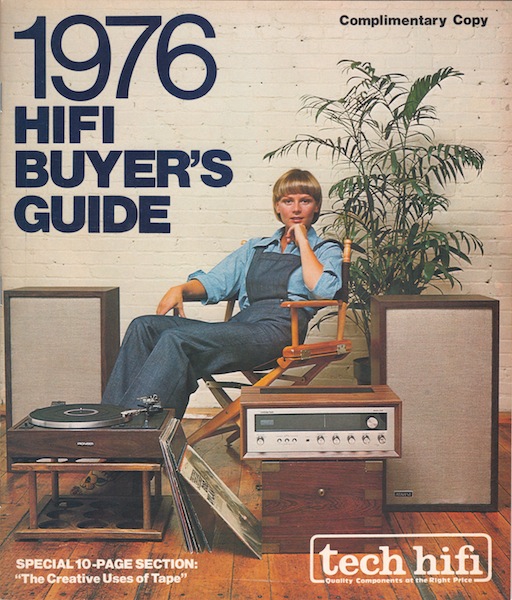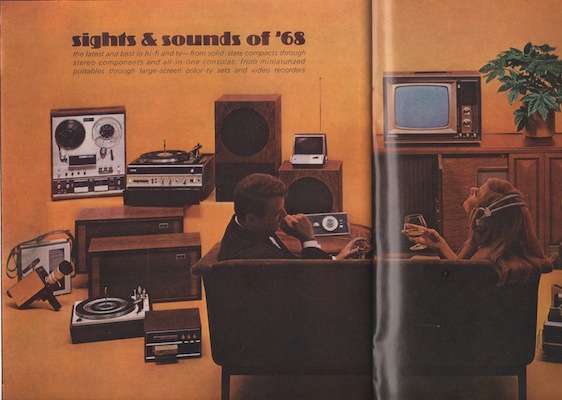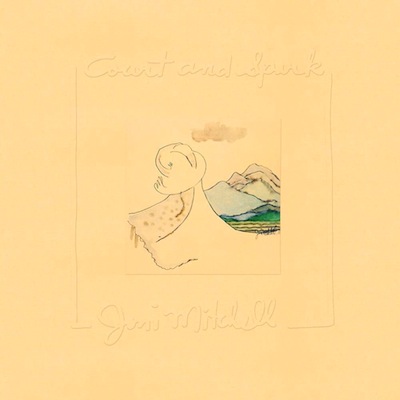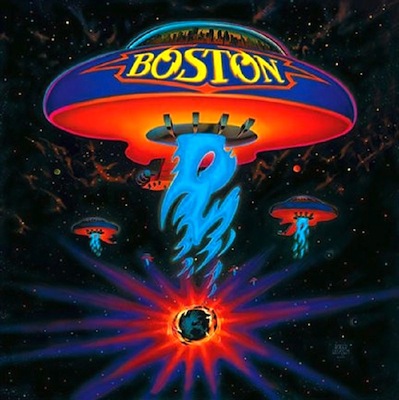
Boston: “More Than a Feeling”
The rock band Boston’s 1976 breakthrough single, “More Than a Feeling” is a song about listening to a song. Or, more precisely, “More Than a Feeling” is a song about experiencing the cascade of emotions—nostalgia, regret, and longing—set in motion by listening to one specific song.
The “old” song the songwriter has been listening to is… “Walk Away Renée.”
Quel surprise!
The year 1976 was a great year for the stereo business. Thinking about the differences in “the industry” between then and now calls to mind L. P. Hartley’s elegant turn of phrase, “The past is a foreign country; they do things differently there.”
Looking back upon high-fidelity component audio’s market-share peak, Tech Hifi co-founder Sandy Ruby observed, “Electronics retailers felt better about themselves than they should have. In the glory days of audio, we were modestly successful businessmen, buoyed by a tidal wave.”
Before I turn my attention to the song at hand, I want to explore what went into building that tidal wave, so that where “More Than a Feeling” fit into it will make more sense. More, after the jump.

The component-audio tidal wave resulted from a combination of: demographics and economics, evolving social mores, developments in material culture and technology, and developments in the arts. However, I assert, most important of all was the music of that era. From the Grateful Dead to George Benson to Fleetwood Mac to Van Morrison, and many others.
The children who had been born during the post-WWII Baby Boom were entering into their earning years, even if their earnings were only part-time. To take one anecdotal example, my high-school girlfriend’s first major purchase, made with earnings from re-shelving books in the local library, was a KLH compact stereo. But earning power was not the only thing going on in the social sphere. Of equal importance was that, in response to the (purported) education-gap wake-up call that Sputnik provided; or, to avoid the Vietnam-era military draft (or both), unprecedented numbers of high-school graduates were going on to attend college.
Before the material-culture-and-technology revolution of watching movies at home (and on demand) by means of rented or purchased videocassettes, your on-demand cultural-entertainment choices were exactly two: you could read a book, or you could listen to a long-playing (LP) vinyl phonograph record. In theory, you could make a landline telephone call to your local radio station and “request” that they play a certain song. But, as a rule, radio stations played only what the programming manager thought pulled best. (In exactly the same way, the manager of your local one-screen movie house decided how many weeks The Absent-Minded Professor would run.)
If you wanted to choose what you listened to, you had to have a stereo system that played LPs. By the mid-1970s, most college dorm rooms did—even if the “stereo” was of the “suitcase” variety.
I have previously made the case in the pages of Stereophile magazine that the place of component audio within the 1950s-1970s vision of “the good life” was inextricably intertwined with the then-prevailing social mores of dating, mating, and family formation.
If you have not yet read that article, you really should, here.
 Back in the day, Playboy magazine frequently featured articles about hi-fi.
Back in the day, Playboy magazine frequently featured articles about hi-fi.
Here’s the crux of my argument:
Back then, a sizable proportion of an impressionable population (in 1972, 25% of college-age males bought Playboy) was being told—authoritatively—that component hi-fi was an important part of “building an image.” I think that back then, a lot of audio equipment was bought by people who really didn’t care all that passionately about music or sound—it just kept them from having to answer an embarrassing question once they got the girl back to their apartment [or dorm room]: “Where is your hi-fi?”
My claim that mass-market acceptance of component audio was driven by the college experience is supported by the geographical distribution of stereo stores—most prevalently in college towns. In the early-to-mid 1970s, there were four stereo stores in among the somewhat scattered buildings of the Brown University campus, and another stereo store perhaps a mile away. (Today, there is not even one.)
Tech Hifi was founded circa 1965 in a dorm room at the Massachusetts Institute of Technology. The business model was to buy audio equipment at discounted retail prices in New York City and resell it (out of the dorm room) for less than the Boston-area brick-and-mortar stores were charging. (That worked only because the dorm room was already paid for.)
Local electronics merchants protested to the university about the unfairness of this subsidized competition. However, in a triumph of The Law of Unintended Consequences, their forcing Tech Hifi out of a nondescript dorm room and into a main-street storefront was the beginning of the end for most of them. Tech Hifi’s Business Model 2.0 was to hire only passionately enthusiastic and knowledgeable salespeople, while not relying exclusively upon products from established companies.
Both Tech Hifi and its New England competitor Tweeter Etc. (founded 1972) expanded amazingly quickly, bringing unprecedented levels of investment and sophistication to mass-market audio showrooms and marketing.
Former Stereophile magazine subscriber Harry Pearson launched his own Quixotic magazine The Absolute Sound in 1973. The original iteration was quarterly, and it contained no advertising. TAS (as it was often called) had a major influence upon the marketplace, bringing before the public the products of equally Quixotic companies such as nouveau-retro (founded 1970) vacuum-tube electronics maker Audio Research Corporation.
It seemed, back in the day, that the business model of many non-chain audio stores was to become a dealer for whatever products HP had raved about in the most recent issue of TAS. The early 1970s were also the glory days of mainstream/mid-fi Stereo Review, which, at its peak, printed more than 300,000 copies of each monthly issue.
There was a dizzying amount of new audio gear coming out, and there were buyers with ready cash. With the exception of a handful of mail-order companies, brick-and-mortar retailing was the only sales channel.
Certainly, demographics and technology (or, the fact that competing technologies such as on-demand video in the home, projection television, and computer games were not yet factors in the marketplace) were important. All that said, the most important factor was the growth of the popular-music business and the flowering of such remarkable creativity, diversity, and innovation.

In the same month (January 1974) that Joni Mitchell’s Court and Spark was released, these other artists also released LPs that charted: Elvis Presley, Graham Nash, Hot Tuna, Grace Slick, Rod Stewart/Faces, Bobby Womack, Bob Dylan, Blue Magic, Linda Ronstadt, Foghat, Gram Parsons, Carly Simon, Brian Eno, Harmonia, The Love Unlimited Orchestra, Leo Sayer, Gordon Lightfoot, and Barbra Streisand. And that’s only one month’s worth of new releases.
Importantly, recording technology had developed to the point where if an artist could imagine a sound, the right producer most likely could make it happen. The Beatles’ Sgt. Pepper’s Lonely Hearts Club Band was just the beginning. In the same general time frame as we are examining, analog synthesizers had their popular-acceptance breakthrough with Walter (later Wendy) Carlos’ Switched-On Bach (released 1968). Switched-On Bach spent four years at the top of the Billboard Classical chart.
To sum up: There were many reasons for component audio to have had its Golden Age in the 1970s. The prime reason was that there was an unprecedented amount of great popular music being recorded. Also, popular music on vinyl LPs did not have much competition for peoples’ entertainment attention spans or dollars. Furthermore, the music being recorded was increasingly sophisticated in terms of audio fidelity and production technology. Finally, fans of the music were willing to spend serious money to enter into the experience provided by recorded music more deeply, by listening on pieces of equipment with greater capabilities.
That brings us back full circle, to the rock band Boston’s 1976 breakthrough single, “More Than a Feeling.” As I mentioned above, this is a song about listening to a song, and its emotional tone is a mixture of nostalgia, regret, and longing. There has never been a shortage of sad songs. But “More Than a Feeling” is unusually complex, which might account for its remarkable popularity and staying power.

“More Than a Feeling” was the first single released from Boston’s self-titled début album. The album Boston eventually sold more than 17 million copies. The YouTube music video embedded above has been viewed more than 147 million times. “More Than a Feeling” is an evergreen perennial of the Classic Rock format. It was the astonishing success of the single “More Than a Feeling” that made Boston the first rock group in history to have Madison Square Garden as the venue for their New York City début performance.
The complexity of “More Than a Feeling” begins in its, for lack of a better word, soundworld. Unusually for its time, the song fades in, as though we are intruding upon an ongoing reverie. The timbres are both densely layered, and distinctive in character (including guitar harmonics and harmonic chords).
Band founder Tom Scholz layered multiple guitar tracks, often using effects pedals of his own devising—remember, back then, laying down a track, effects, and processing were all analog, and all recorded to analog tape—and then, at emotional climaxes, Scholz mixed in singer Brad Delp, singing the exact same notes and bends as the guitars. At first listen, you might not even notice that there is a human voice in that thick mix.
I think that the ultimate complexity is, that for a song that is full of nostalgia, regret, and longing, “More Than a Feeling” moves along very smartly and dynamically.
The song that inspired “More Than a Feeling” of course is “Walk Away Renee.” However, in comparison to “More Than a Feeling,” “Walk Away Renee” sounds like a funeral Mass; it really makes you want to lend singer Steve Martin your handkerchief.
In contrast, between its clap-along chorus and listeners’ near-universal desire to play Air Guitar on the bridge (the guitar solo itself is a tribute to the melody of “Walk Away Renee”), the up-tempo ballad “More Than a Feeling” can make you feel pretty darn good about feeling bad.
Now, of course, Tom Scholz did not invent the concept of emotional cognitive dissonance between a song’s music and the meaning of its lyrics. That has been a feature of art music for centuries. Still, it’s a bit unusual in popular music.
One can’t end an analysis, however brief and superficial, of “More Than a Feeling” without mentioning the sound effect I refer to as the “stinger.” This first happens at 0 minutes 40 seconds into the song. I had assumed that the effect was electronic, but musicologist Rick Beato says that the effect is a “pick drag,” wherein the guitarist slides the edge of the guitar pick up the string at a right angle, and as he or she does so, the windings on the string create resistance and vibration.
Of course, the pick drag does not just sit there passively, in one place in the soundstage! No! There has to be a stereo effect, too.
However it was done, I am sure that that arresting sound sold many pieces of audio gear in the mid-to-late 1970s.
That’s because you can’t sell audio gear without there being music that is worth listening to more than once.
Could a corollary of that be, that when the “music in the air” is not worth listening to more than once, it’s more difficult to sell audio gear? (And now, do I have to go into rehab?)
Here’s “More Than a Feeling’’ ’s “stinger”:
And here are a couple of audio examples of “More Than a Feeling” ’s musical links to “Walk Away Renée.” (“Walk Away Renée” excerpt first, “More Than a Feeling” second.)
The first solo-guitar lick of “More Than a Feeling” can be heard as a response to (or a completion of) the first part of the melody of “Walk Away Renée” ’s chorus:
And the drum hits in “More Than a Feeling” are quite similar to “Walk Away Renée” ’s own version of The Mahlerian Drum Hits of Existential or Romantic Doom:
In addition to the musical links, the text itself tells us that the songwriter cannot forget his lost love, nor can he forget seeing her walk away. The text also tells us that since then, he has “wander[ed] on,” presumably alone. Just like the 16-year old composer of “Walk Away Renée” and his one-way street sign and vacant lot.
That said, admittedly, there are many songs about lost love, and watching a love interest walk away, and being alone. The most prominent of which is perhaps Hal David’s and Burt Bacharach’s “Walk on By,” written in 1963 for Dionne Warwick.
But if the musical and textual clues are not enough: Tom Scholz has several times stated that “Walk Away Renée” inspired “More Than a Feeling.” You can’t argue with that.
# # #



Times certainly change.
College is way, way more expensive than it was when Boston released that album. Way, way beyond inflation.
My own kid finds that is a major factor in her generation’s interests. Who can afford a modern stereo system or has the space to place loudspeakers? Who has the time for sitting down to listen to an album? And, who has the ability to focus for the length of a record?